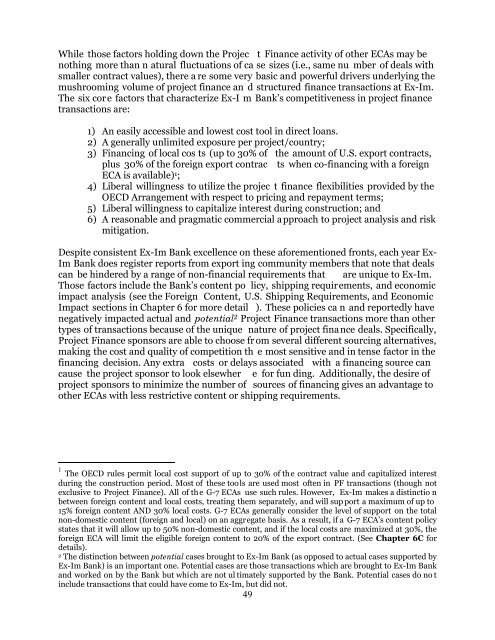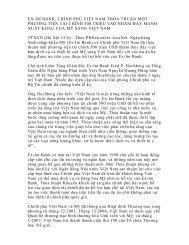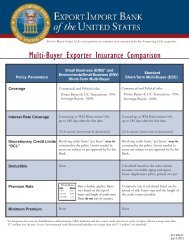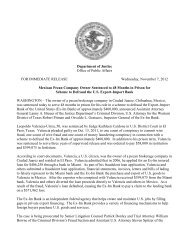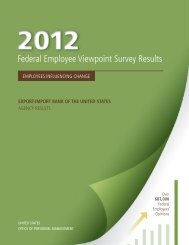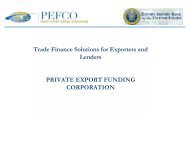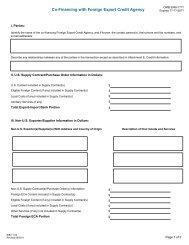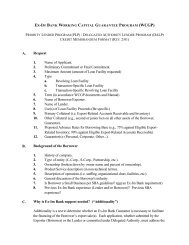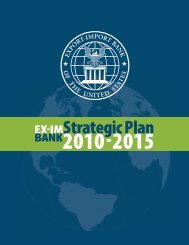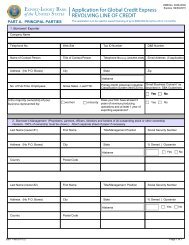2011 508 accessible version - Export-Import Bank of the United States
2011 508 accessible version - Export-Import Bank of the United States
2011 508 accessible version - Export-Import Bank of the United States
- No tags were found...
You also want an ePaper? Increase the reach of your titles
YUMPU automatically turns print PDFs into web optimized ePapers that Google loves.
While those factors holding down <strong>the</strong> Projec t Finance activity <strong>of</strong> o<strong>the</strong>r ECAs may benothing more than n atural fluctuations <strong>of</strong> ca se sizes (i.e., same nu mber <strong>of</strong> deals withsmaller contract values), <strong>the</strong>re a re some very basic and powerful drivers underlying <strong>the</strong>mushrooming volume <strong>of</strong> project finance an d structured finance transactions at Ex-Im.The six core factors that characterize Ex-I m <strong>Bank</strong>’s competitiveness in project financetransactions are:1) An easily <strong>accessible</strong> and lowest cost tool in direct loans.2) A generally unlimited exposure per project/country;3) Financing <strong>of</strong> local cos ts (up to 30% <strong>of</strong> <strong>the</strong> amount <strong>of</strong> U.S. export contracts,plus 30% <strong>of</strong> <strong>the</strong> foreign export contrac ts when co-financing with a foreignECA is available) 1 ;4) Liberal willingness to utilize <strong>the</strong> projec t finance flexibilities provided by <strong>the</strong>OECD Arrangement with respect to pricing and repayment terms;5) Liberal willingness to capitalize interest during construction; and6) A reasonable and pragmatic commercial approach to project analysis and riskmitigation.Despite consistent Ex-Im <strong>Bank</strong> excellence on <strong>the</strong>se aforementioned fronts, each year Ex-Im <strong>Bank</strong> does register reports from export ing community members that note that dealscan be hindered by a range <strong>of</strong> non-financial requirements that are unique to Ex-Im.Those factors include <strong>the</strong> <strong>Bank</strong>’s content po licy, shipping requirements, and economicimpact analysis (see <strong>the</strong> Foreign Content, U.S. Shipping Requirements, and EconomicImpact sections in Chapter 6 for more detail ). These policies ca n and reportedly havenegatively impacted actual and potential 2 Project Finance transactions more than o<strong>the</strong>rtypes <strong>of</strong> transactions because <strong>of</strong> <strong>the</strong> unique nature <strong>of</strong> project finance deals. Specifically,Project Finance sponsors are able to choose fr om several different sourcing alternatives,making <strong>the</strong> cost and quality <strong>of</strong> competition th e most sensitive and in tense factor in <strong>the</strong>financing decision. Any extra costs or delays associated with a financing source cancause <strong>the</strong> project sponsor to look elsewher e for fun ding. Additionally, <strong>the</strong> desire <strong>of</strong>project sponsors to minimize <strong>the</strong> number <strong>of</strong> sources <strong>of</strong> financing gives an advantage too<strong>the</strong>r ECAs with less restrictive content or shipping requirements.1 The OECD rules permit local cost support <strong>of</strong> up to 30% <strong>of</strong> <strong>the</strong> contract value and capitalized interestduring <strong>the</strong> construction period. Most <strong>of</strong> <strong>the</strong>se tools are used most <strong>of</strong>ten in PF transactions (though notexclusive to Project Finance). All <strong>of</strong> th e G-7 ECAs use such rules. However, Ex-Im makes a distinctio nbetween foreign content and local costs, treating <strong>the</strong>m separately, and will sup port a maximum <strong>of</strong> up to15% foreign content AND 30% local costs. G-7 ECAs generally consider <strong>the</strong> level <strong>of</strong> support on <strong>the</strong> totalnon-domestic content (foreign and local) on an aggregate basis. As a result, if a G-7 ECA’s content policystates that it will allow up to 50% non-domestic content, and if <strong>the</strong> local costs are maximized at 30%, <strong>the</strong>foreign ECA will limit <strong>the</strong> eligible foreign content to 20% <strong>of</strong> <strong>the</strong> export contract. (See Chapter 6C fordetails).2 The distinction between potential cases brought to Ex-Im <strong>Bank</strong> (as opposed to actual cases supported byEx-Im <strong>Bank</strong>) is an important one. Potential cases are those transactions which are brought to Ex-Im <strong>Bank</strong>and worked on by <strong>the</strong> <strong>Bank</strong> but which are not ul timately supported by <strong>the</strong> <strong>Bank</strong>. Potential cases do no tinclude transactions that could have come to Ex-Im, but did not.49


